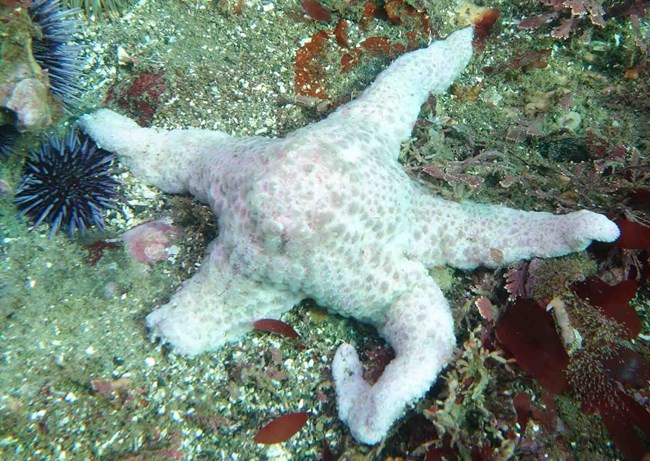Last updated: October 26, 2022
Article
Sea Star Assemblages Changed After Wasting Disease

We conducted intertidal surveys between 2005 and 2018 at 20 sites (5 sites in each of 4 sub-regions) within the Gulf of Alaska. This time period included years prior to the emergence of sea star wasting disease and recovery after, which allowed us to compare the spatial patterns of sea star assemblages and the environmental variables that influence them.
We found that prior to the impacts of wasting disease, sea star assemblages were primarily correlated with the presence of tidewater glaciers, fetch, and tidal range. After the disease played out, we found that the newly structured assemblages correlated with slope, fetch, and tidal range. We also documented lower sea star density and diversity after wasting disease.
While sea star wasting disease manifested at different times across the Gulf of Alaska and did not impact all species uniformly across the sites, this work provides insights on sea star habitat preferences and tolerance ranges as well as their interaction with physical environmental factors.
Wasting disease and static environmental variables drive sea star assemblages in the Northern Gulf of Alaska
Abstract
Sea stars are ecologically important in rocky intertidal habitats where they can play an apex predator role, completely restructuring communities. The recent sea star die-off throughout the eastern Pacific, known as Sea Star Wasting Disease, has prompted a need to understand spatial and temporal patterns of sea star assemblages and the environmental variables that structure these assemblages. We examined spatial and temporal patterns in sea star assemblages (composition and density) across regions in the northern Gulf of Alaska and assessed the role of seven static environmental variables (distance to freshwater inputs, tidewater glacial presence, exposure to wave action, fetch, beach slope, substrate composition, and tidal range) in influencing sea star assemblage structure before and after sea star declines. Environmental variables correlated with sea star distribution can serve as proxies to environmental stressors, such as desiccation, attachment, and wave action. Intertidal sea star surveys were conducted annually from 2005 to 2018 at five sites in each of four regions that were between 100 and 420 km apart across the northern Gulf of Alaska. In the pre-disease years, assemblages were different among regions, correlated mostly to tidewater glacier presence, fetch, and tidal range. The assemblages after wasting disease were different from those before the event with lower diversity and lower density. In addition to these declines, the disease manifested itself at different times across the northern Gulf of Alaska and did not impact all species uniformly across sites. Post sea star wasting, there was a shift in the environmental variables that correlated with sea star structure, resulting in sea star assemblages being highly correlated with slope, fetch, and tidal range. In essence, sea star wasting disease resulted in a shift in the sea star assemblage that is now correlating with a slightly different combination of environmental variables. Understanding the delicate interplay of environmental variables that influence sea star assemblages could expand knowledge of the habitat preferences and tolerance ranges of important and relatively unstudied species within the northern Gulf of Alaska.
Konar, B., T. J. Mitchell, K. Iken, H. Coletti, T. Dean, D. Esler, M. Lindberg, B. Pister, and B. Weitzman. 2019. Wasting disease and static environmental variables drive sea star assemblages in the Northern Gulf of Alaska. Journal of Experimental Marine Biology and Ecology 520: 151209
